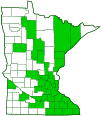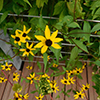Brown-eyed Susan
(Rudbeckia triloba var. triloba)
Conservation • Weed • Wetland • Description • Habitat • Ecology • Use • Distribution • Taxonomy
Conservation Status |
|||
| IUCN Red List | not listed |
||
| NatureServe | N4N5 - Apparently Secure to Secure S3 - Vulnerable |
||
| Minnesota | Threatened |
||
Wetland Indicator Status |
|||
| Great Plains | FACU - Facultative upland |
||
| Midwest | FACU - Facultative upland |
||
| Northcentral & Northeast | FACU - Facultative upland |
||
Description |
Brown-eyed Susan is an erect, biennial or short-lived perennial forb that rises on one to several stems from rhizomes and shallow, fibrous roots. It can be 12″ to 60″ tall, though in Minnesota it is usually no more that 40″ in height at maturity. The stems are erect, green, and ridged. They are frequently branched above the middle, giving the plant a bushy appearance. They are sparsely to moderately covered with conspicuous, white hairs, especially toward the top. The hairs near the top of the stem are mostly spreading, those near the base mostly pointed downwards. The stems are sometimes hairless near the base. They are not covered with a whitish, waxy coating (glaucous). Basal leaves are on long, mostly winged leaf stalks. The blades are 4″ to 11¾″ long, ¾″ to 3″ wide. They are egg-shaped to broadly egg-shaped in outline. They are tapered to slightly heart-shaped at the base. At least some of the larger leaves are usually deeply divided into 3 lobes. The lobes are egg-shaped or lance-shaped and are tapered to a sharply-pointed tip. The upper and lower surfaces are moderately covered with conspicuous, white, spreading hairs and with minute, yellow glands. They are slightly rough to the touch and are not glaucous. The margins are usually toothed with sharp, forward-pointing teeth. Lower stem leaves are alternate, up to 8″ long and 3″ wide, and otherwise similar to basal leaves. Basal and lower stem leaves are often absent at flowering time. Stem leaves become smaller, less divided, and shorter-stalked as they ascend the stem. Middle and upper stem leaves are stalkless or on short, winged leaf stalks. Upper leaves sometimes clasp the stem. Middle and upper leaf blades are up to 4¾″ long, up to 1¼″ wide, narrowly lance-shaped, egg-shaped, or elliptic, rounded at the base, and tapered to a sharp point at the tip. The inflorescence is a loose, open, branched cluster (panicle) of 10 to 30 flower at the end of the stem and branches. The whorl of bracts at the base of the flower head (involucral bracts) are ¼″ to ½″ long, lance-shaped to linear, bent backward, and moderately hairy. The flower heads are 1″ to 1¾″ in diameter. There are 8 to 15 yellow ray florets and 100 to 300 or more dark brownish-purple disk florets. The disk is 3 ⁄16″ to ⅜″ in diameter and is in the shape of a flattened cone. The flowers are not fragrant. The fruit is a dry, black, oblong, 4-angled, 1 ⁄16″ to ⅛″ long cypsela with no fluffy tuft of hairs attached. |
Height |
12″ to 60″ |
Flower Color |
Yellow ray florets, brownish-purple disk florets |
Similar Species |
|
Habitat |
Wet to moderate moisture. Openings or lightly shaded areas in moist hardwood forests and floodplain forests, thickets, roadsides, and disturbed areas. Full or partial sun. |
Ecology |
Flowering |
Early August to mid-September |
Pests and Diseases |
|
Use |
|
Distribution |
||
|
Sources 2, 3, 5, 6, 7, 24, 28, 29, 30. Biodiversity occurrence data published by: Minnesota Biodiversity Atlas (accessed through the Minnesota Biodiversity Atlas Portal, bellatlas.umn.edu, 9/5/2025). It should be noted that R. triloba var. triloba is a popular and widely sold garden plant. Occasionally, it is found near an abandoned garden or in an old field and thought to be native. Usually such plants originated from a garden supplier in another state and consequently have no conservation value in Minnesota. Only native plants growing in native habitats qualify as "threatened" in Minnesota. Only the counties in dark green represent “native plants growing in native habitats” and qualify as “threatened”. |
|
| 9/5/2025 | ||
Nativity |
||
Native |
||
Occurrence |
||
Rare in native habitats |
||
Taxonomy |
|
Kingdom |
|
Subkingdom |
Pteridobiotina |
Phylum |
Tracheophyta (Vascular Plants) |
Class |
|
Order |
Asterales (Sunflowers, Bellflowers, Fanflowers, and Allies) |
Family |
Asteraceae (Sunflowers, Daisies, Asters, and Allies) |
Subfamily |
Asteroideae |
Tribe |
Heliantheae (Sunflowers and Allies) |
Subtribe |
Rudbeckiinae (black-eyed Susans, coneflowers, and prairie coneflowers) |
Genus |
Rudbeckia (black-eyed Susans and coneflowers) |
Section |
Rudbeckia |
Species |
Rudbeckia triloba (brown-eyed Susan) |
Subordinate Taxa |
|
|
|
Synonyms |
|
Centrocarpha aristata Centrocarpha triloba Rudbeckia aristata Rudbeckia beadlei Rudbeckia biennis Rudbeckia scabra. Rudbeckia triloba var. beadlei |
|
Common Names |
|
browneyed Susan brown-eyed Susan common three-lobe coneflower thin-leaf coneflower three-leaved coneflower three-lobe coneflower three-lobed coneflower |
|
Glossary
Bract
Modified leaf at the base of a flower stalk, flower cluster, or inflorescence.
Clasping
Describing a leaf that wholly or partly surrounds the stem but does not fuse at the base.
Cypsela
A dry, one-chambered, single-seeded fruit, formed from a single carpel, with the seed attached to the membranous outer layer (wall) only by the seed stalk; the wall, formed from the wall of the inferior ovary and also from other tissues derived from the receptacle or hypanthium, does not split open at maturity, but relies on decay or predation to release the contents.
Glaucous
Pale green or bluish gray due to a whitish, powdery or waxy film, as on a plum or a grape.
Involucre
A whorl of bracts beneath or surrounding a flower, flower head, or flower cluster.
Panicle
A pyramidal inflorescence with a main stem and branches. Flowers on the lower, longer branches mature earlier than those on the shorter, upper ones.
Rhizome
A horizontal, usually underground stem. It serves as a reproductive structure, producing roots below and shoots above at the nodes.
Winged leaf stalk
A leaf stalk with a leaf-like or membrane-like extension along both sides.
Visitor Photos
Share your photo of this plant.
This button not working for you?
Simply email us at info@MinnesotaSeasons.com.
Attach one or more photos and, if you like, a caption.
Nancy Lundquist |
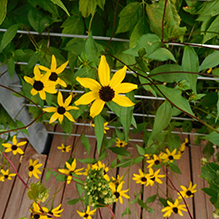 |
MinnesotaSeasons.com Photos
 |
 |
|
Habitat |
Habitat |
|
 |
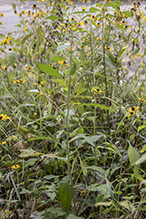 |
|
Plant |
Plant |
|
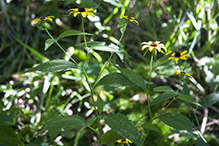 |
 |
|
Upper stem leaves |
Lower lobed leaves |
|
 |
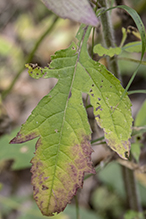 |
|
Lower lobed leaves |
Lower lobed leaves |
|
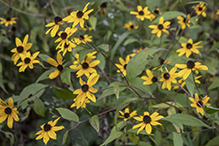 |
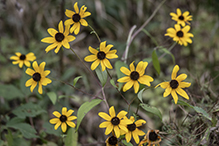 |
|
Flowers |
Flowers |
|
 |
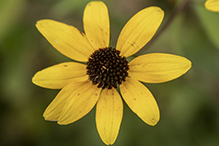 |
|
Flowers |
Flower head |
|
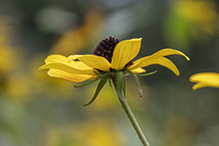 |
||
Involucral bracts |
|
|
 |
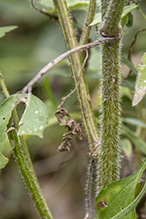 |
|
Involucral bracts |
Stem |

Slideshows

Visitor Videos
Share your video of this plant.
This button not working for you?
Simply email us at info@MinnesotaSeasons.com.
Attach a video, a YouTube link, or a cloud storage link.
Other Videos
Brown-eyed Susan (Rudbeckia triloba)
PrairieMoonNursery

Visitor Sightings
Report a sighting of this plant.
This button not working for you?
Simply email us at info@MinnesotaSeasons.com.
Be sure to include a location.
A/C Christian
Church of
Minneapolis
7/22/2023
Location: Westwood Hills Nature Center
At the Westwood Hills Nature Center, we saw some life on July 22 this year.
This was all found by the A/C Christian Church of Minneapolis.
Minnesota Seasons Sightings

